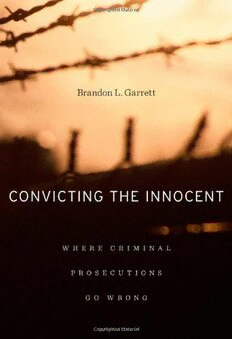
Convicting the Innocent: Where Criminal Prosecutions Go Wrong PDF
Preview Convicting the Innocent: Where Criminal Prosecutions Go Wrong
Convicting the Innocent Convicting Innocent the WHERE CRIMINAL PROSECUTIONS GO WRONG Brandon L. Garrett Harvard University Press Cambridge, Massachusetts • London, En gland 2011 Copyright © 2011 by the President and Fellows of Harvard College All rights reserved Printed in the United States of America Library of Congress Cataloging- in- Publication Data Garrett, Brandon L., 1975– Convicting the innocent : where criminal prosecutions go wrong / Brandon L. Garrett. p. cm. Includes bibliographical references and index. ISBN 978- 0- 674- 05870- 5 (alk. paper) 1. Judicial error— United States. 2. Evidence, Criminal— United States. 3. Post- conviction remedies— United States. I. Title. KF9756.G37 2011 345.73'064—dc22 2010037172 To the exonerees whose stories are told here and to the innocent people who have not yet been exonerated Contents 1. Introduction 1 2. Contaminated Confessions 14 3. Eyewitness Misidentifi cations 45 4. Flawed Forensics 84 5. Trial by Liar 118 6. Innocence on Trial 145 7. Judging Innocence 178 8. Exoneration 213 9. Reforming the Criminal Justice System 241 Appendix 277 Notes 291 Ac know ledg ments 351 Index 355 chapter 1 Introduction In October 1993, Ronald Jones sat on death row in Illinois waiting to be executed. He had been sentenced to death for a gruesome rape and murder in Chicago. Jones clung to one last request— for a DNA test, which he claimed would prove his innocence. His lawyers off ered to pay the $3,000 that it would cost to do the test. At the time, only a handful of people had ever proven their innocence using postconviction DNA test- ing. The prosecutors opposed testing, arguing that it would make no diff erence. Indeed, there appeared to be overwhelming evidence of Ron- ald Jones’s guilt. Cook County circuit judge John Morrissey agreed and angrily denied the motion, exclaiming, “What issue could possibly be resolved by DNA testing?”1 Eight years before, in March 1985, the victim, a twenty-e ight-y ear-o ld mother of three, was out dancing late with her sister on the South Side of Chicago. She was hungry and decided to get food a few blocks from her home at Harold’s Chicken Shack. She ran into a friend on the street. As they talked, a panhandler approached; people in the neighborhood had nicknamed him “Bumpy,” because of his severe acne. “Bumpy” asked the friend for fi fty cents. She gave him fi fty cents and all three parted ways. Several hours later, the victim was found half- naked and dead in a nearby alley behind the abandoned Crest Hotel. She had been stabbed 1
